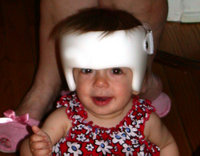Craniofacial dysostosis
Crouzon Syndrome is a type of genetic disorder known as a branchial arch syndrome. Specifically, this syndrome affects the first branchial (or pharyngeal) arch, which is the precursor of the maxilla and mandible. Since the branchial arches are important developmental features in a growing embryo, disturbances in its development create lasting and widespread effects. more...
Overview
This syndrome is named after Octave Crouzon, a French physician who first described this disorder. She noted the affected patients were a mother and her daughter implying a genetic basis. First called Craniofacial Dysostosis, the disorder was characterized by a number of clinical features, which to this date has no known single, initiating defect to account for all of its characteristics.
Breaking down the name, "craniofacial" refers to the skull and face, and "dysostosis" refers to synostosis (a union between adjacent bones or parts of a single bone).
Now known as Crouzon Syndrome, the disease can be described by the rudimentary meanings of its former name. What occurs in the disease is that an infant's skull and facial bones, while in development, fuse early or are unable to expand. Thus, normal bone growth cannot occur. Fusion of different sutures lead to different patterns of growth of the skull. Examples include: trigonocephaly (fusion of the metopic suture), brachycephaly (fusion of the metopic suture), dolichocephaly (fusion of the sagittal suture), plagiocephaly (fusion of coronal and lambdoidal sutures), oxycephaly (fusion of most sutures).
Causes
As stated previously, there is evidence for a genetic basis to this disorder, but there is also no known series of events leading to all the manifestations present. Instead, it is more accurate to view the symptoms arising independently from one another.
As in many syndromes, aberrations in chromosomes seem to be responsible in some cases, and in particular there is support that this disorder may propagate in an Autosomal Dominant mode. Evidence shown is that males and females are affected equally and affected offspring tend to have an affected parent. Furthermore, some researchers point to the long arm of chromosome 10 as a possible location for a genetic abnormality.
On the other hand, 20-40% of people with this disorder have no family history of this disorder, meaning that there is little likelihood of a familial inheritance in those cases. Thus, it is believed that a cause may be a fresh mutation, or, alternatively, an environmental disruption of the developing embryo which results in the same physical characteristics as the genetically-derived disorder. In other words, though genetic anomalies may be leading to a disruption of embryogenesis, facts suggest an important role of environmental factors.
Symptoms
As a result of the changes to the developing embryo, the symptoms are very pronounced features, especially in the facial areas. Low-set ears is a typical characteristic, as in all of the disorders which are called branchial arch syndromes. The reason for this abnormality is that ears in fetal life are much lower than those on an adult. During normal development, the ears "travel" upward on the head but, in these cases, do not follow this normal pattern of development since these syndromes have the greatest effects on the head.
Read more at Wikipedia.org



